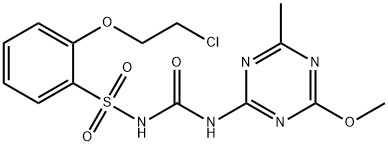CHEMICAL AND PHYSICAL PROPERTIES
| Color/Form | Fine white powder |
|---|---|
| Melting Point | 178.1 °C (decomposes) |
| Solubility | In water, 1.5 g/L (pH 7) at 20 °C |
| Density | 1.5 g/cu cm |
| Vapor Pressure | Vapor pressure: 7.5X10-13 mm Hg at 20 °C |
| LogP | log Kow = 1.1 (pH 5.0), -0.59 (pH 6.9), -1.8 (pH 9.0) at 25 °C |
| Stability/Shelf Life | Stable under recommended storage conditions. |
| Decomposition | Hazardous decomposition products formed under fire conditions: Carbon oxides, nitrogen oxides (NOx), sulfur oxides, hydrogen chloride gas. |
| Ionization Efficiency | Positive |
| Dissociation Constants | pKa = 4.64 |
| Other Experimental Properties | Henry's Law constant = <2.5X10-10 atm-cu m/mole at 23 °C (estimated from vapor pressure and water solubility (pH 5); calculated value at pH7 and pH9 will be even lower due to higher water solubility |
SAFETY INFORMATION
| Signal word | Warning |
|---|---|
| Pictogram(s) |
 Exclamation Mark Irritant GHS07  Environment GHS09 |
| GHS Hazard Statements |
H332:Acute toxicity,inhalation H410:Hazardous to the aquatic environment, long-term hazard |
| Precautionary Statement Codes |
P261:Avoid breathing dust/fume/gas/mist/vapours/spray. P271:Use only outdoors or in a well-ventilated area. P273:Avoid release to the environment. P391:Collect spillage. Hazardous to the aquatic environment P501:Dispose of contents/container to..… |
COMPUTED DESCRIPTORS
| Molecular Weight | 401.8 g/mol |
|---|---|
| XLogP3 | 2.3 |
| Hydrogen Bond Donor Count | 2 |
| Hydrogen Bond Acceptor Count | 8 |
| Rotatable Bond Count | 7 |
| Exact Mass | 401.0560675 g/mol |
| Monoisotopic Mass | 401.0560675 g/mol |
| Topological Polar Surface Area | 141 Ų |
| Heavy Atom Count | 26 |
| Formal Charge | 0 |
| Complexity | 560 |
| Isotope Atom Count | 0 |
| Defined Atom Stereocenter Count | 0 |
| Undefined Atom Stereocenter Count | 0 |
| Defined Bond Stereocenter Count | 0 |
| Undefined Bond Stereocenter Count | 0 |
| Covalently-Bonded Unit Count | 1 |
| Compound Is Canonicalized | Yes |
PRODUCT INTRODUCTION
description
Triasulfuron is an N-sulfonylurea that is N-[o-(2-chloroethoxy)phenyl]sulfonylurea in which one of the hydrogens attached to the non-sulfonylated nitrogen has been replaced by a 4-methoxy-6-methyl-1,3,5-triazin-2-yl group. A herbicide used to control broad-leaved weeds in cereals, its use within the EU has been banned after September 2017 on the grounds of potential groundwater contamination and risks to aquatic life. It has a role as a herbicide and an agrochemical. It is an aromatic ether, a N-sulfonylurea, a member of 1,3,5-triazines and an organochlorine compound.

